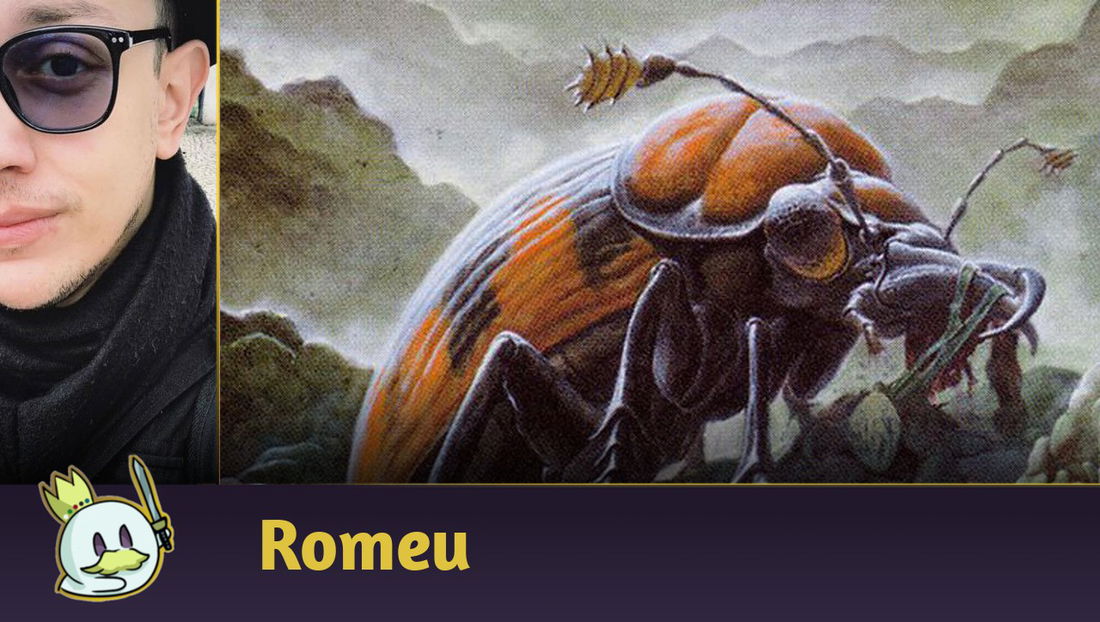With over three decades of existence, the history of Magic: The Gathering as a competitive card game is one of the most fascinating to know for TCG enthusiasts. Many of the fundamentals that permeate many other games were born with Magic, and many of these came not only from design decisions but also from the construction of more innovative decks.
To celebrate this long history, we started a series of articles about the decks that left their mark in Magic, strategies that changed the way of thinking about the game, building lists, which cards to add and even the way the TCG was designed.
We have divided the series into three episodes - one for each decade - and in this second article, we delve into the decks between 2004 and 2013, a period of considerable changes in the game and the improvement of concepts created from last decade.
Decks that made History in Magic - 2004–2013
2004 - Affinity
If you ask any long-time Magic player what the biggest game-changing event of all time was, chances are that most of them will mention Affinity, a mechanic originally released in the Mirrodin block that completely disrupted competitive Standard due to the effectiveness of its ability with the famous Artifact Lands, released in the same block.
The impact on the competitive Metagame was so great that Standard tournaments at that time were reduced to two archetypes: Affinity or Anti-Affinity, like the Astral Slide deck of Julien Nujiten, who won the world championship with two copies of Akroma’s Vengeance and a full set of Viridian Shaman in the maindeck along with Eternal Witness for recursion.
Ad
To see the damage that this strategy did to Magic, just look at the Sideboard of the list above: Affinity was so prevalent that the only game it needed to worry about was the mirror, where the combination of Seething Song with Furnace Dragon was the best way to close the game, while Annul counters threats in the early game and Serum Visions serves exclusively to find key cards earlier.
2005 - Canadian Threshold
Tempo decks have been around since Alan Comer first established the Turbo Xerox theory, and players began exploring cards like Gush and Daze with Quirion Dryad to create lists that could reduce their lists to 12 lands due to the amount of cheap or free spells that were available.
However, Tempo decks have evolved over the years, and before we get to the fateful Delver variants that became the benchmark for this archetype, Canadian Threshold laid the groundwork for the modern iterations of this deck in Legacy.
Fetch Lands changed how players viewed the Threshold mechanic since it made it much easier to increase the number of cards in the graveyard by taking natural actions in the game like playing lands, and Nimble Mongoose was one of the best low-cost threats that existed in the game for years, both when it was complemented by Werebear, a 4/4 for 
2006 - Zoo
Ad
Zoo is a deck that has existed in the game since the list for the first World Championship finals created by Betrand Lestree, but it officially gained this name around 2006, through a list that ran several low-cost, high-power creatures, such as Kird Ape, Isamaru, Hound of Konda and Watchwolf, combined with cheap damage spells and other means of pressuring the opponent's life to guarantee quick victories - in this case, even in a Metagame with Umezawa's Jitte.
The list above, by Craig Jones, literally made history in the finals of the Pro Tour Honolulu, in a feat recorded live and called by the Magic; The Gathering channel as the “Topdeck of the Century”.
2007 - The Sliver Kids
Here's a fun story: in 2007, Wizards experimented with the Two-Headed Giant Draft format at a Pro Tour, that is, a Limited game where players participated in pairs, shared the same pool of cards and played together in a Best of One match with 30 life.
Ad
What should have been a balanced and exciting tournament was broken in the Top 8 by two newcomers to the Pro Tour circuit: Americans Chris Lachmann and Jacob Van Lunen drafted a Slivers deck, an archetype underestimated by the other competitors, and played the fastest Top 8 matches in the history of a Pro Tour - all thanks to a loophole in the Two-Headed Giant rules: ten Poison counters are still enough to win the game.
With three copies of Virulent Sliver and double mana resources to play multiple Slivers early with both decks without compromising the consistency by not having to run multiple colors in a single list, the so-called “Sliver Kids” dominated the Top 8 match after match, even going head-to-head with renowned names in competitive Magic, such as Jon Finkel and Yuta Takahashi.
2008 - Faeries
Faeries made history for years in Standard as one of the best decks in the history of the game in the 2000s and one of the most popular and challenging archetypes to play in its time.
During both the Time Spiral/Lorwyn and Lorwyn/Alara seasons, it became the dominant strategy to the point where cards like Bitterblossom and Cryptic Command were at some point considered design mistakes by Mark Rosewater.
2009 - Cruel Control
Ad
Despite the fame and success of Faeries in the Lorwyn/Alara season, another admitted design mistake of the block was the interaction between Reflecting Pool and the Vivid Lands (Vivid Marsh, Vivid Meadow, Vivid Crag, Vivid Creek and Vivid Grove) that made it too easy to access five colors in decks like the famous Cruel Control, which took full advantage of this interaction to cast, respectively, 



Its popularity, however, grew in the hands of Gabriel Nassif during the Pro Tour Kyoto, in another moment that will forever be recorded in the history of competitive Magic:
2010 - Jund
Jund is known as one of the most influential decks in Modern's history (which would only officially come into existence the following year), but its origins begin in Standard after Alara Reborn brought Bloodbraid Elf and Cascade, which changed the dynamics of the format's mana curve and, after the rotation, made Jund the most efficient archetype of the entire Alara/Zendikar season, and created the foundations for what would become, a few years later, the reference for how a Midrange should work in competitive Magic.
2011 - Caw-Blade
Ad
The Zendikar/Scars of Mirrodin season started with one fact already evident since the first Pro Tour: Jace, the Mind Sculptor was the absolute best card in the format. If you wanted to play Standard competitively back then, you had to be ready to deal with Jace, even using copies of Jace Beleren as a “removal” due to an old rule that only allowed one Planeswalker of the same type (in this case, Jace) on the board - a common strategy at the time.
However, the Magic community was willing to deal with Mind Sculptor as the most powerful card in the Metagame as long as it allowed for a diversity of archetypes, but the release of Mirrodin Besieged brought the perfect support tool for Stoneforge Mystic - Sword of Feast and Famine, whose ability allowed lands to be untapped when the equipped creature dealt combat damage, essentially generating a “pseudo-extra turn”.
Combined with Squadron Hawk, these three pieces gave rise to Caw-Blade, one of the most prevalent decks in Standard's history due to its high-efficiency and distinct plans that complemented each other: in some games, it was possible to just use Squadron Hawk and Stoneforge Mystic to pressure the opponent in every combat while the imminent threat of Jace, the Mind Sculptor forced them to preserve their resources. In others, players would focus so much on countering the beatdown plan that Jace would dominate the late game with his Fateseal ability until finishing the game with his ultimate.
The combination of these led to Standard being in its worst state since Affinity, and for the first time in seven years, a ban in the format was necessary, removing Jace, the Mind Sculptor and Stoneforge Mystic from Standard, and would set a precedent that would be used years later to make direct interventions more common - and, more often than not, necessary - in the rotating format.
2012 - Delver
UW Delver was chosen as the representative list for the mere fact that it marked that era in Standard, but the real legacy here is the way Delver of Secrets changed deckbuilding forever.
Ad
The mix of cheap cantrips like Brainstorm, Ponder, and Preordain that was already valued in Legacy became even more important when Innistrad introduced a blue one-drop that could become a 3/2 with Flying as early as turn two, as long as your list followed the necessary deckbuilding concessions - and so, Delver of Secrets took over all formats and became the main Tempo reference in Standard, Legacy and even Pauper, which was still in its early stages that year.
Its reign lasted for nine years until power creep took it away from competitive tables for a while, but to this day, Delver continues to be one of the archetypes that sustain competitive Legacy, now with its main card accompanied by Dragon’s Rage Channeler and Murktide Regent.
2013 - The Aristocrats
There was a time when social media didn't have the reach it has today to circulate information quickly enough that the big news of one day could be known to the entire world within the next two hours, and back then, the biggest excitement of watching a Pro Tour was seeing which cards would stand out the most and which new decks would emerge with the latest expansion.
This was partly the case for Aristocrats, designed by Sam Black and piloted by Tom Martell and two other players during Pro Tour Gatecrash. The list used the improved mana base of Godless Shrine and Sacred Foundry and sought to extract as much as possible from the card that became an instant staple: Boros Reckoner, a clean answer to the dominance of Thragtusk in Standard, which in turn was released as an answer to Delver decks last season.
The sum of all these elements created a largely synergistic archetype around Human-type creatures with a sacrifice subtheme with Falkenrath Aristocrat and Cartel Aristocrat alongside Blood Artist, establishing an archetype that attacked on many fronts while, at the same time, giving rise to a strategy that is now very well-known and a nomenclature reference in Commander.
Conclusion
Ad
That's all for today!
If you have any questions, feel free to leave a comment!
Thanks for reading!











— Comentarios0
Be the first to comment